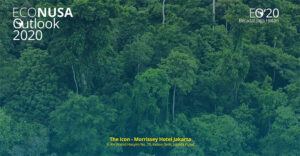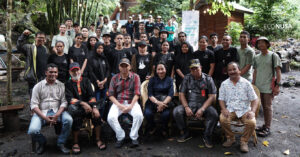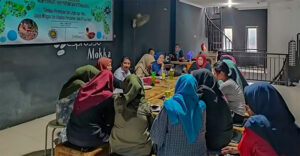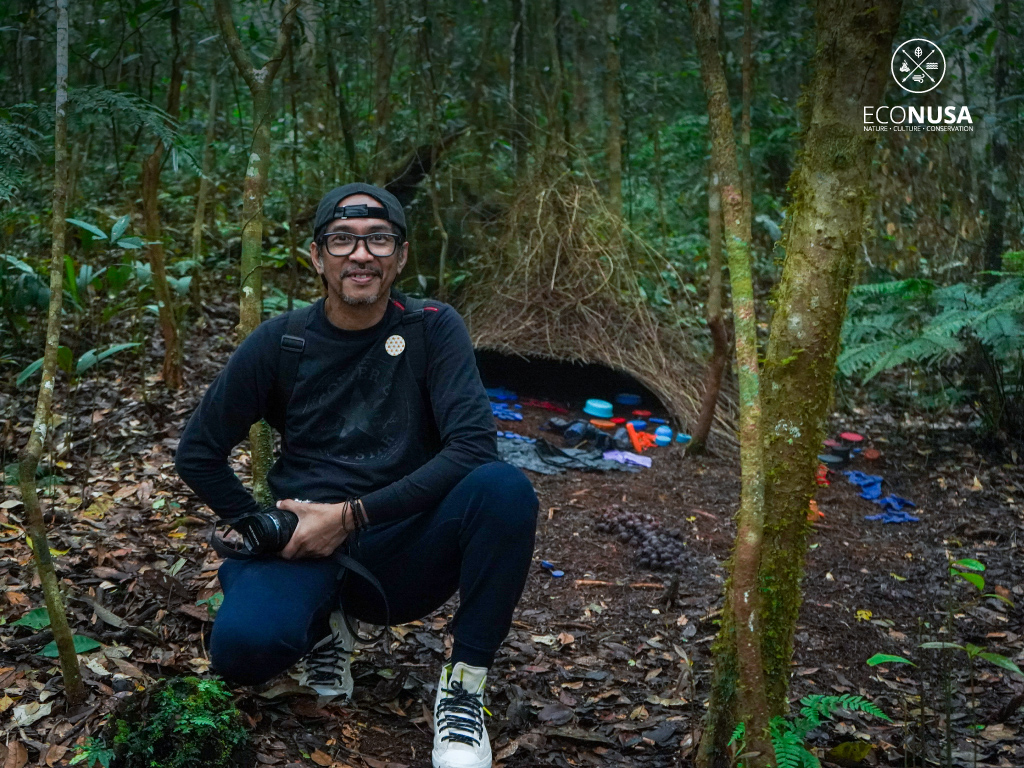
In the middle of the primary forest of the Arfak Mountains, when the sun had just appeared, Muhammad Ridwan Hafiedz alias Ridho Hafiedz, became one of the lucky men who saw the beauty of paradise (bird of paradise) in its natural habitat. The guitar picker of the Slank music group has fulfilled the list of “achievements” for ornithologists to come to Papua and see the charm of paradise before facing the Creator.
“This is a rare opportunity for me. Apart from being far from where I live in Jakarta, there are also few opportunities to see the Cenderawasih directly,” said Ridho.
The gratitude was expressed after Ridho observed several birds of paradise from inside the observation hut measuring 2 by 5 meters on Sunday (20/6/2021). Through a 300 millimeter camera lens, Ridho saw Parotia Arfak (Parotia sefilata), Black Sicklebill (Epimachus fastosus), and Vogelkop Superb Bird-of-Paradise (Lophorina niedda). Unfortunately, the “goddess of luck” hasn’t gone any further to be able to watch Vogelkop Lophorina and Parotia Arfak dance to attract the opposite sex.
To go to the “playground” of the birds of paradise, Ridho left around 5 am from Hans Mandacan’s Papua Lorikeet homestay. Hans is one of the ecotourism managers in the Arfak Mountains who has been involved in the practice of environmental services since 2009. Since then, Hans has been protecting the forest around Mount Soeti from the threat of illegal logging and hunting.
With alacrity, Ridho tread the path that had been shown by Hans. The additional beam from the head flashlight helps light the way. It took 1 hour to the observation location by covering a distance of about 750 meters. After entering the observation hut, there should be no sound at all so that the Cenderawasih will not be disturbed. Only darkness and the sound of mosquitoes that continue to be heard.
The day before, Ridho witnessed how Namdur Polos (Amblyornis inornatus) arranged his nest by taking into account the aesthetics of color. This bird, endemic to the Arfak Mountains, groups certain colors around the nest which come from packaging bottle caps, plastic keresek, bowls, and flowers. So, it’s no exaggeration when Hans and the people of the Arfak Mountains call this little architect a “smart bird”.
“On the first day, we saw a smart bird. He separates the colors to design the nest to attract the opposite sex. Very cool,” said Ridho.
Before setting foot in the Land of Heaven, the paradise in Ridho’s mind was a yellow bird with dangling feathers. Publications related to paradise generally only feature the Greater Bird-of-Paradise (Paradisaea apoda) and Red Bird-of-Paradise (Paradisaea rubra) figures. In fact, the Paradisaeidae family consists of about 40 species of birds with different characteristics.
Especially in the Arfak Mountains, there are 4 endemic Cenderawasih that will not be found anywhere else. Apart from Parotia Arfak and Vogelkop Superb Bird-of-Paradise, only the Long-tailed Paradigalla (Paradigalla carunculata) and Arfak Astrapia (Astrapia nigra) have not been seen from behind the observation hut. Vogelkop Superb Bird-of-Paradise itself was only discovered in 2016 when Edwin Scholes, an ornithologist, and Tim Laman, a wildlife photographer, went through the forests of Tanah Papua to do research on the Bird-of-Paradise Project.
“It turns out that there are a lot of Cenderawasih. It’s not just a yellow paradise. Western Parotia is part of Cenderawasih. I myself just found out that there are so many species of Cenderawasih,” said Ridho.
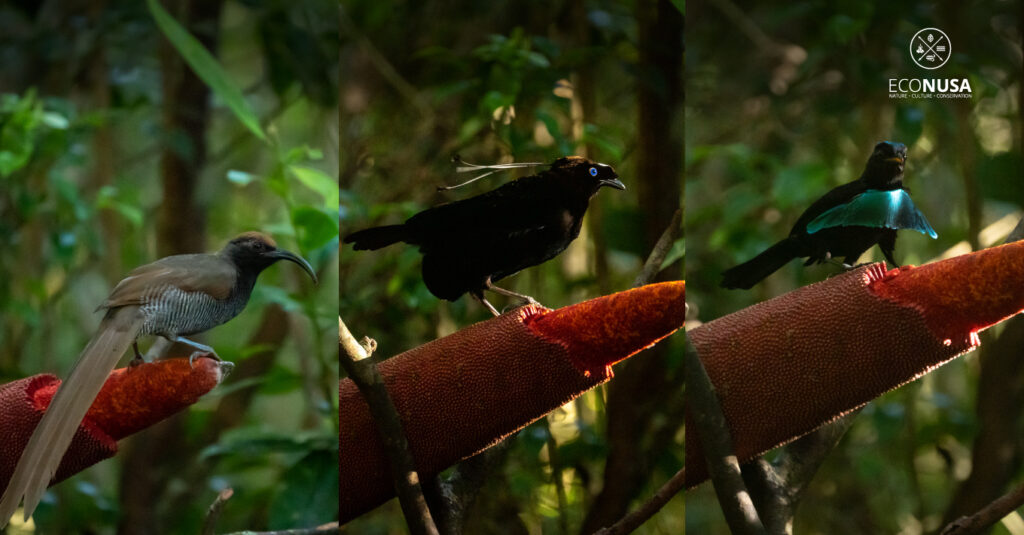
Ridho is grateful that the people around the Arfak Mountains still adhere to traditional values in protecting their nature. Communities around the Arfak Mountains know igya ser hanjop or guarding boundaries. The local wisdom divides the space based on different designations.
Susti is used for living, gardening, and places of worship. Nimahamti is a buffer zone, where people hunt and gather with the permission of the customary head. Meanwhile, Bahamti is a primary forest zone. Bird watching ecotourism is only a “small bonus” from the application of local wisdom related to spatial planning.
“The existence of ecotourism in a place like this for me, actually they already care about their natural resources. It’s a form of awareness,” said Ridho.
Ridho hopes that the forest in the Arfak Mountains will continue to be maintained. He could not imagine if the Cenderawasih no longer had a place to live; no sound echoes in the forest and no captivating dance. “Tourists who come here must know the rules too. We as guests must also follow what the local community has instructed us to do,” he said.
The area around the Arfak Mountains has attracted many people to visit. Not only for tourists, researchers and explorers are noted to have set foot in Arfak. Thomas Barbour, an American zoologist, visited Lake Anggi to collect reptiles and amphibians in 1906-1907. There is also L. S. Gibbs, explorer and scientist who collected more than 330 species of plants from Lake Anggi.
The Arfak Mountains were designated as a nature reserve in 1992 through the Decree of the Minister of Forestry No. 783/Kpts-II/1992. The Arfak Mountains Nature Reserve (CAPA) is home to 110 species of mammals, 320 species of aves, and 2,770 species of orchids. Thus, it is not surprising that the Arfak Mountains attract many people to visit it.
Realizing the natural beauty of the Arfak Mountains, Hans Mandacan decided to open up as a tour guide who had a big influence on his life. His repentance after becoming a hunter paid off. Nature returned to health and society benefited better than hunting.
“Ecotourism is not detrimental because those who come only cover and take pictures. One bird we have guarded for years can bring in more than Rp. 50 million. That is, we see ecotourism means a lot to us. They get photos and we get money for the community. That’s why we have to protect the forest, preserve what’s in the area,” said Hans. Please give your support in preserving the paradise and forests in Papua and the Maluku Islands. Voice your opinion through the #DefendingParadise campaign at bit.ly/defendingparadise
Editor: Leo Wahyudi & V. Arnila Wulandani


